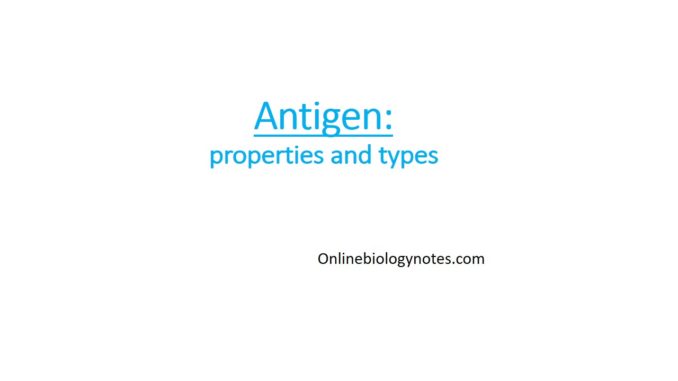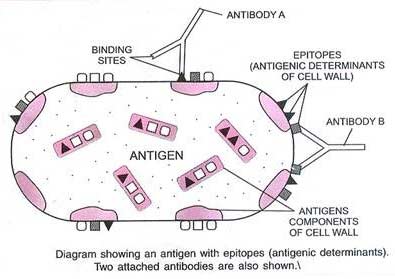
What is Antigen?
- Any substance such as proteins, carbohydrates and lipid present in bacteria, fungi, parasites and viruses are considered foreign to Human or any vertebrate host and have the capacity to induce immune response is known as Antigen.
- Lipids and nucleic acids are only antigenic when combined with proteins or polysaccharides
- Molecular weight of 10,000 Daltons or higher
- Immunogen:
- Antigen which when introduced into vertebrate host, induces a specific immune response is called immunogen. They can mobilize immune system and provoke immune response
- Incomplete antigen:
- A substance which can bind with specific antibody but cannot induce immune response by itself is known as incomplete antigen or hapten.
- These small foreign molecules that is not antigenic and must be coupled with a carrier molecules to be antigenic. Once antibody are formed, they will recognize haptens.
- Antigenicity:
- the ability of compound or foreign molecules to combine specifically with antibody is known as antigenicity.
- Immunogenicity:
- the ability of the molecule to induce immune response. Immunogenicity of an antigen is determined by four properties; Foreigness, molecular size, chemical composition and heterogenicity and ability to be processed and presented on the surface of Antigen presenting cells (APCs).

Antigenic determinant
- Functional binding area which is immunologically active regions of an immunogen (or antigen) that binds to antigen-specific membrane receptors on lymphocytes or to Fab region of secreted antibodies. It is also called antigenic determinants or Epitopes.
- Antigenic determinant is the region of antigen molecule that is bound by Fab region of Antibody or TCR of T-lymphocytes
- The antibody or TCR does not interact with antigenic macromolecules as a whole but only with distinct portion of the molecule called antigenic determinant or epitope.
- Antigenic determinant may include- sugars, aminoacids and other organic molecules.
- A sequence of 4-6 amino acids is optimal size of an antigenic determinant of a protein antigen.
- Paratopes: the corresponding binding site of antibody (Fab region) to epitopes of antigen is called paratopes.
- Most antigens are multivalent. Note that the valancy of an antigen refers to the number of epitopes present in the antigen molecule. There are two type of epitopes in antigen. They are surface epitopes and hidden epitopes. Only surface epitopes can binds to Fab of antibody. Therefore, total number of surface epitopes represent functional valency of antigen. However, total valency of antigen is number of hidden and surface antigens.
Properties of antigen/ factor determine immunogenicity
- Foreignness:
- In order to induce immune response molecule must be foreign to the host. Immune response (antibody) is not produced against self antigen
- Immunogenicity of an antigen increase with increase in degree of foreignness. Generally greater the phylogentic gap between two species, greater will be the immune response.
- For example, Bovine serum albumin (BSA) isolated from calf induce strong immune response when injected into Birds than in cattles.
- However, there are some exception to above rule, for example- some hidden proteins of human beings ( Lens protein, sperm protein, thyroglobulin etc) when injected into same host, they induce immune response. Similarly collagen and cytochrome C are highly conserved during evolution, therefore these proteins from any species when injected do not induce or induce very little immune response.
- Molecular size:
- There is correlation between molecular size of antigens and immunogenicity.
- Most active immunogen have molecular weight of 1 lakh (100,000 Da) or more.
- Generally substances with molecular mass less than 5,000 Da are poorly immunogenic.
- Chemical composition and heterogenicity:
- Proteins are the most potent immunogen with carbohydrate ranking the second. In contrast Lipid and nucleic acids generally do not act as antigen (immunogen) unless they are complexed with protein or carbohydrates.
- Homopolymers composed of polymer of single type of aminoacis or monosaccharides and are less immunogenic.
- Heteropolymers are usually more immunogenic. Therefore from above it is clear that in order to be immunogenic, molecules must be complexed and heterogeneous in composition.
- Susceptibility to antigen processing and presentation:
- The development of both Antibody mediated immunity (AMI) and Cell mediated immunity (CMI) requires interaction of T-cells with antigen that has been processed and presented on the surface of Antigen presenting cells (APCs) along with MHC molecules.
- Larger and insoluble molecules are more immunogenic than small and soluble molecule because larger molecules are more easily phagocytosed and presented by APCs.
- The molecule that cannot be phagocytosed and presented by APCs with MHC are poorly immunogenic.
- Furthermore the antigenic molecules must be digestable by hydrolytic enzyme of APCs. For example; polymer of D-aminoacids are poorly immunogenic because the hydrolytic enzymes of APC can only degrade L-aminoacids but not D-aminoacids.
Biological system that determines immunogenicity of antigen
Even if a molecule has properties to contribute to immunogenicity (such as foreignness, molecular size, chemical composition and heterogenicity and susceptible to Antigen processing and presenting), its ability to induce immune response depends on certain biological system.
- Dose and route of administration:
- Dose of antigen determines the amount of antibody produced in immunized host. An insufficient dose of antigen will not stimulate immune response either because it fails to activate enough T and B-lymphocytes or because of immunological tolerance in some cases. Conversely, excessive high dose can also induce tolerance.
- Again single dose of most immunogen will not induce string immune response. Rather repeated administration over a period of weeks is required. Such repeated administration is called boosters.
- If antigen is injected repeatedly, T-cells and B-cells are activated for long time and antibodies are produced in greater amount. Therefore, such principle is applied during vaccination.
- Route of administration of antigen determine type of lymphoid organ where T cells and B-cells are activated for antibody production.
- The immunogens are generally administrated through parenteral than orally.
- The antigen administrated intravenously is carried to spleen where it activates T and B cells. On the other hand if antigen is injected subcutaneously, it enters into lymph node and activates T cells and B cells.
- Genotype of recipient host:
- A major factor that determine immune response is genotype of recipient host. The genetic constitution of immunized host influence the type and degree of immune response.
- For example, Hugh and McDeritt showed two strain of mice responded differently after exposure to synthetic immunogen. One strain produce high immune response while other strain produce low. When they were crossed, the F1 generation showed intermediate immune response.
- The immune response of an animal to antigen is influenced and control by gene along with other environmental factors.
- Adjuvants:
- Adjuvants are substances that when mixed with antigen and injected with it, enhances the immunogenicity of that antigen.
- Adjuvants are used in research and clinical trials to increase the immunogenicity of antigen with low immunogenicity or available in low amount. They are mixed with antigen to prepare vaccine.
- For example; antibody response of mice toward BSA can be increased five folds or more if BSA is administered with adjuvants.
- Some of known adjuvants are synthetic polysaccharides and bacterial lipopolysaccharides.
- Adjuvants increase the immunogenicity by various ways. For examples- Alums
- Alums is an adjuvant that prolongs the persistence of antigen. It is the only adjuvant approved to human use. When antigen is mixed with alum, it causes precipitation of antigen. When this precipitate Ag-alum complex is injected, it results in slow release of antigen from injection site and thus activates immune system for long time.
- The alum precipitate also increase molecular size of antigen thus increase the susceptibility of antigen processing and presentation.
- Other commonly used adjuvants are- LPS, heat killed Mycobacterial cells etc.
- Effects of adjuvants:
- Antigen persistence is prolonged
- Co-stimulatory signals are enhanced
- Local inflammation is increased
- Non-specific proliferation of lymphocytes is stimulated
Types of Antigens
I. On the basis of immunogenicity:
- Complete antigen or immunogen:
- Molecules that induce specific immune response by themselves are complete antigen or immunogen.
- Eg; Bacteriia, fungi, virus etc
2. Incomplete antigen or haptens:
- Antigens that cannot induce immune response by itself but can bind with specific antibody are called incomplete antigen or haptens.
3. Autoantigens:
- Some self-protein such as lens proteins, sperm protein, myolin basic protein, thyroglobulin, kidney protein and some heart muscle protein are sequestered from blood circulation throughout life. Therefore, these protein are recognized as foreign by T and B cells such that immune response is produced.
4. Allo-antigen or Iso-antigen:
- These antigens are individual specific antigen present in one individuals but not in other.
- Eg. Blood grouping antigen
5. Heterophilic or cross reacting antigen:
- If antigen produced against one antigen binds with other antigen then such antigen are called heterophilic or cross reacting antigen.
- Eg. Antibody produced against Rickettsia bind with some Proteus species. Similarly, antibody produced against M protein of Streptococcus pyogens cross reacts with heart muscle protein of human.
6. Super antigen:
- These antigen activates large fraction of t cells (upto 25%)
- Eg. Staphylococcus enterotoxins, shocks toxins, exfoliating toxin, Pyrogenic exotoxins
7. Tolerogen:
- Antigen that induce immunogenic tolerance ie. Unresponsiveness to antigen that is induced by prior exposure to that antigen.
8. Allorogen:
- Antigen that induce anaphylaxis (severe immediate hypersensitivity reaction) as a result of rapid generalized mast cell activation.
II. On the basis of need help of T cells:
- Thymus dependent antigen:
- These antigen induce both AMI and CMI
- Eg. proteins
2. Thymus independent antigen:
- These antigen induce only AMI
- Eg. Polysaccharides
III. On the basis of origin:
- Exogenous antigens:
- These antigen originate from outside and are foreign to host body
- These antigens enters to the body through inhalation, ingestion, or injection and start circulating in the body fluids and caught up by the APCs (Antigen processing cells such as macrophages, dendritic cells etc.).
- The engulfment of these exogenous antigens by APCs are mainly mediated by the phagocytosis. E.g. Bacteria, Fungi, Viruses etc.
2. Endogenous antigens:
- These antigens originate inside own body. These antigens are body’s own cells or sub fragments or compounds or the antigenic products that are produced as a result of normal cell metabolism, or because of viral or intracellular bacterial infection.
- The endogenous antigens are processed and presented by the macrophages to CD8 T cells (cytotoxic T – cells). E.g. Blood group antigens, HLA (Histocompatibility Leukocyte antigens) etc.
